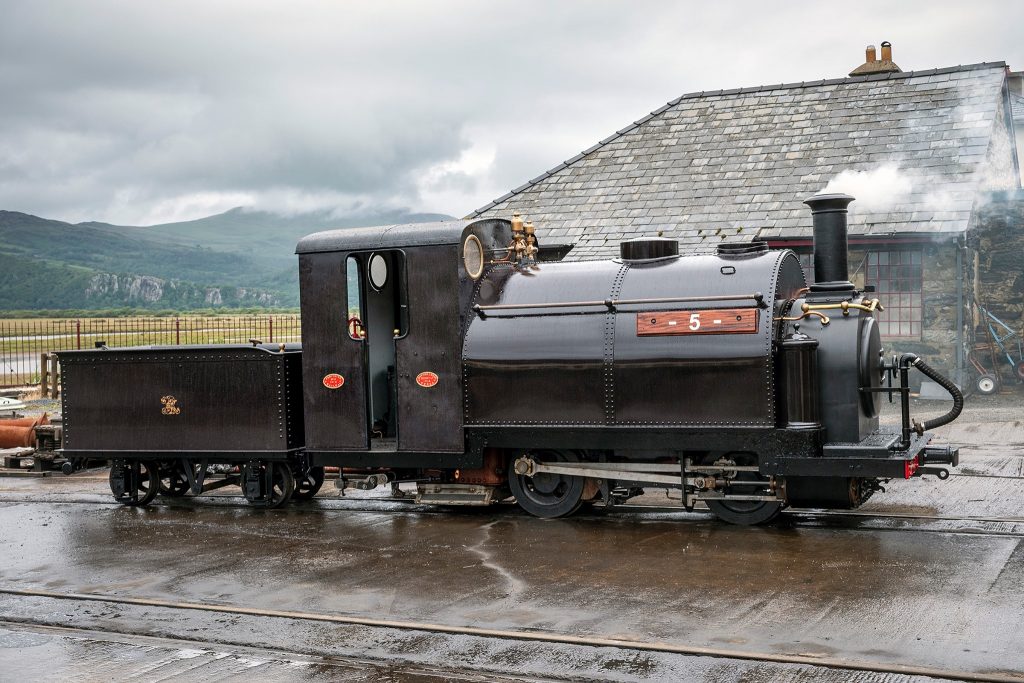
After 80 years of silence, Welsh Pony returned to steam on Saturday 27 June 2020. With Wales still in ‘lockdown’ as a result of Covid-19, only a handful were able to physically attend at Boston Lodge to witness the event, but thousands tuned into live streams online during the day. For those of you who don’t use Facebook, or who don’t ‘follow’ the Heritage Group’s page there, here is Tim Elsby’s history of this special locomotive – for so long ‘unfinished business’, but now ready to canter again.
The beginning
The introduction of steam power in 1863 and then passenger services had transformed the Festiniog Railway. Trains had been getting longer and longer and the four original locos were being pushed to do more than they were designed for. By 1867 Charles Spooner had drawn up a revised specification for a new engine, which he took to George England & Co.
George England managed to persuade the FR to purchase two engines, rather than one. By the end of March 1867 the order had been placed and the first loco arrived in June. This was Welsh Pony, the second loco – Little Giant – was probably delivered in August. They proved to be an instant success, capable of hauling 38 tons up the line, compared to 28 for the original ‘small’ Englands.
The new locomotives had a larger boiler and firebox, higher boiler pressure, a saddle tank, a 6 inch longer wheelbase, and a weatherboard to protect the crew. There were many other detailed design changes based on experiences with the first four locos, as well as two new tenders with the luxury of sprung axle boxes built at Boston Lodge. The updated design is the blueprint for the locos we see today.
This photo shows Welsh Pony in 1872, largely in original condition at Porthmadog. A few changes have been made: double slidebars were fitted after the first year in service, and the whistle is now outside the cab. An interesting feature is the enamel works and nameplates. One of the worksplates was dug up in Glan-y-mor yard 1960s. Proof that the FR never really throws anything away.
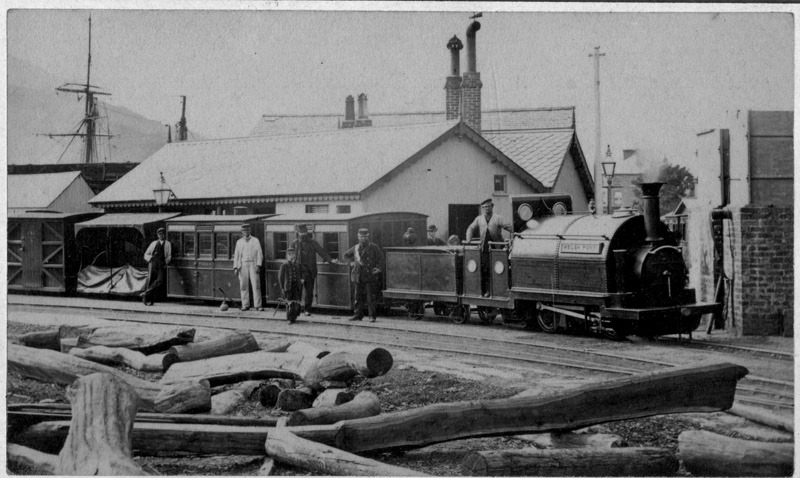
Last days in original condition
This 1886 view shows Welsh Pony at Duffws. In 1880 it had a major overhaul, this involved removing and re-fitting the firebox, replacing the boiler tubes with steel ones, fitting two whistles, and building a new tender.
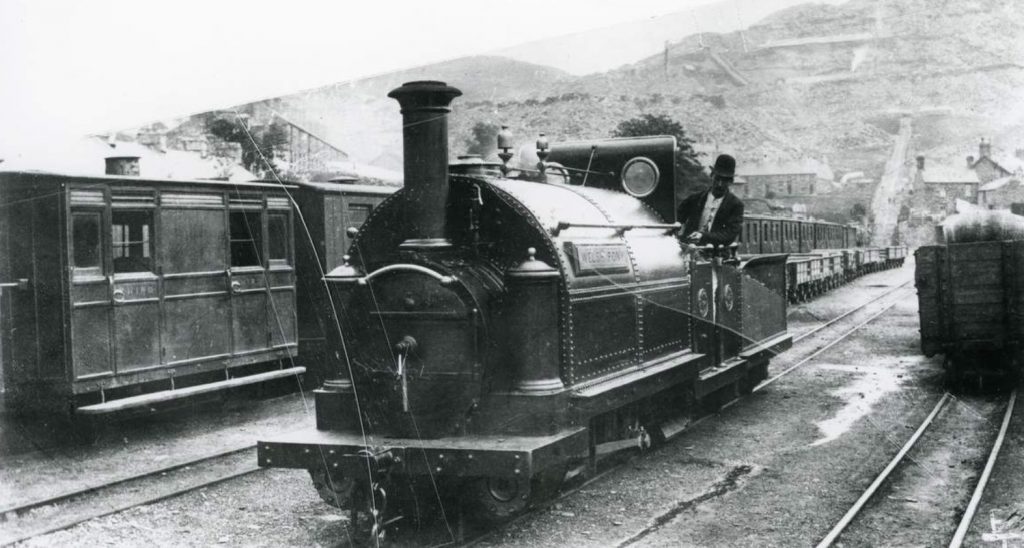
The photo shows the condition the loco was in prior to its first major rebuild. It now has bigger sandpots, a different chimney cap, and several patches on the water tanks. It is probably still in the original green livery, although that was being replaced with the more familiar Indian Red around this time.
By now the England engines had been replaced on the heaviest trains by Double Fairlies. In 1887 Welsh Pony was quoted as having covered 281,700 miles. That’s around 14,000 miles a year for the first 20 years of its life. An impressive feat for a little loco.
In 1888 the then Works Manager William Williams was faced with a fleet of worn out England engines. Rather than building new locos he set about rebuilding Palmerston in the style of Welsh Pony, with the added comfort of a full cab. This would be the blueprint for rebuilding the rest of the fleet.
A report from December 1889 shows the end was near for Welsh Pony, saying “boiler doubtful, tank entirely done up”. Once Little Giant emerged from its own rebuild in July the following year, the old Welsh Pony was put out to pasture. It was officially withdrawn on the 23rd of September 1890. New parts for the rebuild were already well underway by then.
The second boiler
A new boiler was ordered from Vulcan Foundry for £227 15s. For some reason this was 6 inches longer than the one ordered for Little Giant, so Welsh Pony became an extra-large England. Other works included new main frames, cylinders, saddle tank, full cab, and a D shaped smokebox. Balance weights were added in front of the smokebox to improve the ride. Any parts of the old loco that could be re-used were also incorporated.
Welsh Pony emerged from Boston Lodge on the 29th May 1891 in the new Indian Red livery. By October it had also gained a new wooden framed tender No.5, and in 1893 vacuum brakes were fitted to both loco and tender.
Over a period of 7 years the entire shunting loco fleet was completely renewed at a fraction of the cost of buying new locos. It is a testament to the skills of William Williams, the workshop manager and loco superintendent, that over 100 years later 4 of the 5 still survive.
The new boiler seems to have been troublesome however. The loco had frequent firebox repairs throughout the early 1900s, as well as suffering from burst tubes. In 1908 there was a major derailment where the loco fell off a wharf in Minffordd yard into the standard gauges lines. Remarkably, little damage was caused, but it took over 3 hours to recover the engine.
Pony soldiered on with the boiler at reduced pressure. In 1910 there was one final shot at repairing the firebox. It carried on until December 1911 before being taken into the works for another new boiler. In the 20 years and 6 months since the rebuild it was estimated to have covered 397,200 miles.
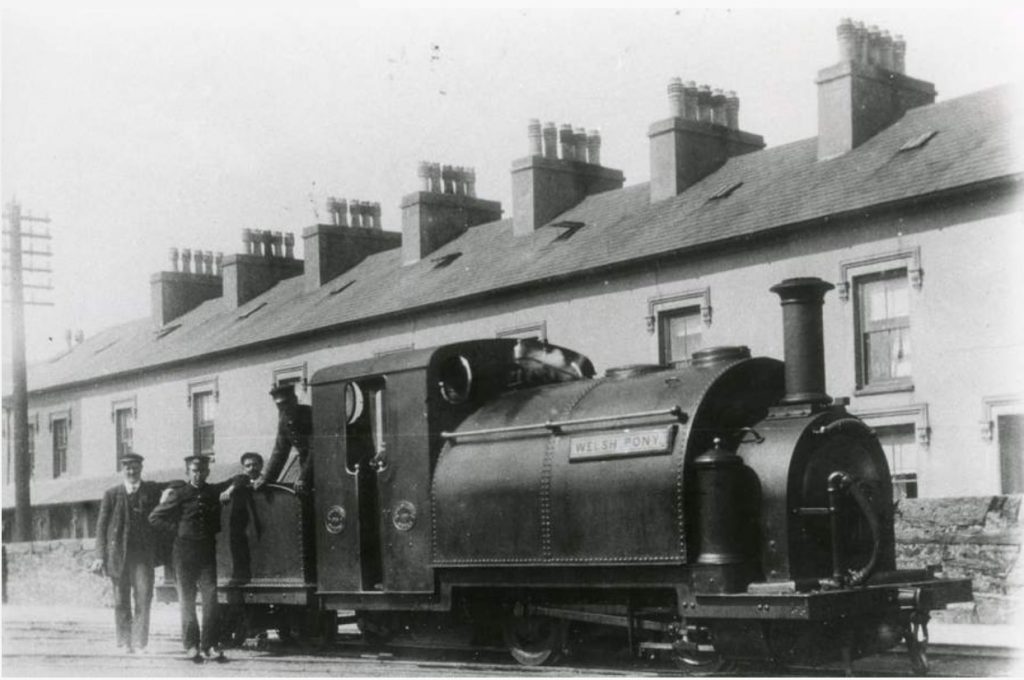
The photo shows Welsh Pony at Porthmadog around 1907. The new cab, tanks and smokebox can be seen. The tank has a small, almost flat dome cover. Vacuum brakes have also been fitted and the loco is running with a wooden framed tender.
Boiler number three
The new boiler arrived from J Adamson & Co in February 1912, but it would be over three years before Welsh Pony ran again. There was a lot pressure to reduce costs at the time; and a limited workforce often spent more time working on quarry locos being rebuilt under contract than they did on the railway’s fleet.
Work on Welsh Pony was sporadic, despite the new boiler being ready to go. In the meantime the smokebox was taken off and put on Prince. In May 1915 Prince was in poor condition and withdrawn due to boiler problems. Unsurprisingly a few weeks later a rebuilt Welsh Pony was out on test. Maintenance records at that time were poor, so we don’t know what was actually done beyond a new boiler. There were a few visual changes. A new smokebox with wraparound handrails, a bigger dome cover, and small cab side plates.
Welsh Pony went back to work until a derailment at Duffws broke the driving axle in 1920. The replacement is still under the loco, neatly stamped “NOV. 20”. Then a couple of years later the cylinders cracked and were patched. The loco limped on for the next year until a new set was cast by the GWR at Swindon.
In 1924 there was a shunting accident at Boston Lodge which destroyed Welsh Pony’s tender, the mangled remains of which could be seen dumped behind the Old Engine Shed for years after. Little Giant had been withdrawn with boiler problems and donated its steel framed tender to Welsh Pony. Sadly the sister engine would never run again and was cannibalised for parts over the next decade. Welsh Pony continued to run until being stopped for major works in May 1928.
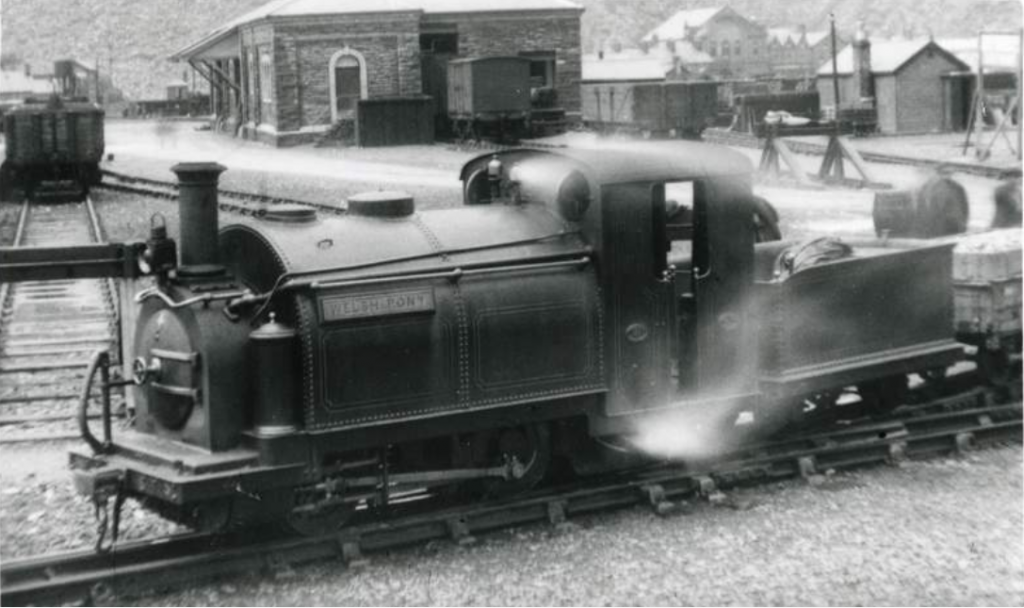
Here you can see Welsh Pony shunting in the LNWR yard at Blaenau. The livery and lining show up well, and the loco looks nice and clean. It even looks like the smokebox hinges have been polished. A cross has been chalked on the smokebox, this probably indicates the driver was a member of The Good Templars – a temperance movement at the time.
Feeling Blue
It would be early in 1930 before the loco ran again. The boiler was repaired at Glaslyn Foundry, perhaps a sign of the diminished capabilities of Boston Lodge. The motion was attended to as well. It is suggested that around this time the best remaining bits of Little Giant were put onto to Welsh Pony. The leading wheel set is probably from that loco.
Boston Lodge lost its last skilled painter in 1927 so by this time locos were painted in a much simpler livery. There would be black borders, but no longer any lining. Lettering was often stencilled on. The railway was attempting to improve its image after being neglected during the 20s, but did so on a budget. Welsh Pony appears to have finally had a repaint around 1932/3, when it was painted into the infamous blue livery. The records refer to this as “Crystal Palace Blue” and a photographer recorded the colour as “bright blue”. It seems likely the original colour was darker and more vibrant, but the paint was poor quality and faded to a pale sky blue rapidly. In the end it was repainted green the next year.
Welsh Pony carried on working both Festiniog and Welsh Highland services throughout the 1930s. There was a steady stream of motion and boiler repairs, maintenance often being reactive rather than proactive. An unusual fault seems to be the dome cover separating from the ring that holds it on to tank. It is often seen to be loose or positioned wrong. There seems to be numerous attempts to repair it with the angle getting increasing wonky over the years.
The photo shows a pale blue Welsh Pony at Porthmadog in 1933. The faded paint shows the livery style of the time well. The dome cover can also sitting at a strange angle.
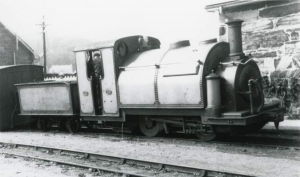
Halfway through the decade problems with the loco fleet were mounting up. In November 1936 Welsh Pony was probably the only working engine. Early the next year Prince would be stripped for an overhaul that would take 18 years; Palmerston had its boiler tested in March, nothing is mentioned of it after then. In April 1939 there are concerns Welsh Pony would not pass its boiler insurance test. The Festiniog must have been very persuasive as both Welsh Pony and Princess were still running when passenger services was suspended on the 15th September 1939.
A summary of Welsh Pony from January 1940 says “The chargehand is afraid this engine will not stand the test without heavy repairs being done or a new firebox”. Despite this there is evidence that it was being used in February that year. There is a rumour that it was pressed into action one last time a few years later when Princess was unavailable, but sadly there is no hard evidence to back this up. So it is likely that it fell out of use at the beginning of 1940. Princess would carry on right until closure in 1946, but neither engine would steam again in the 20th century.
The photo shows a pale blue Welsh Pony at Porthmadog in 1933. The faded paint shows the livery style of the time well. The dome cover can also sitting at a strange angle.
The long wait
In 1954 railway preservationists were successful in clearing the debts and taking control of the Festiniog Railway Company. To run trains again the railway needed engines. Unfortunately most of them were in very poor state. In the Old Engine Shed Welsh Pony kept company with Princess, Merddin Emrys, and the remains of Moel Tryfan. Princess and Merddin had simply been driven into the shed after their last turns and left. Up in the main yard Palmerston was dumped outside, it had been used to power the steam hammer during the war.
Things were slightly more promising in the erecting shop. Taliesin was in the middle of a bogie overhaul when the railway closed. The real bonus was Prince though. It was part way through a major rebuild and there was a brand new boiler ready to go. So it’s not surprising that these two locos were the first to return. They would eventually be followed by Merddin Emrys, the restoration of which is a saga in itself.
This photo, taken by Ron Fisher in 1963, shows the state the loco was found in. Some parts have been removed for use on Prince. Some of the Green livery is just about showing through. The metal bracket below the sand pot is of interest. This was to hold an accumulator which was used in conjunction with the electric headlight of the Baldwin tractor.
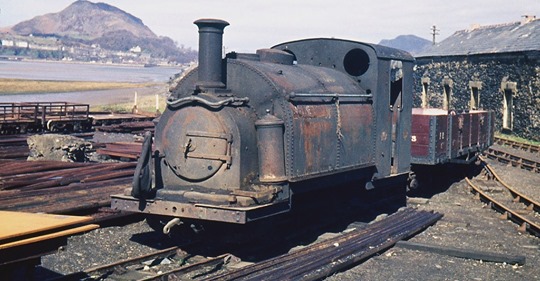
In 1963 two things happened. Firstly Welsh Pony made its one and only trip outside of Wales since it was built, displayed at the Birmingham Model Railway Exhibition in largely untouched condition. Secondly Linda was purchased from the Penrhyn Railway. It had been on loan for a year and despite a few hiccups had proven to be a very capable addition. Sister Blanche would follow the year after.
There initially was an intention to restore Welsh Pony. It was the best of the three engines still untouched, but the arrival of Linda, Blanche, and in 1967 Mountaineer pushed a long and expensive restoration of Welsh Pony well down the list of priorities. It donated its tender to Linda which was then widened to match that loco.
After that it just hung around in various sidings at Boston Lodge, waiting for something to happen. Princess had been cosmetically restored and put on display at both Porthmadog and Blaenau. Palmerston was deemed “beyond restoration” and sold to a consortium of British Rail engineers in 1974. It would run again back on the FR in 1993, after a protracted rebuild. In 1981 Princess was put on display in the museum at Harbour Station, now Spooners bar. Welsh Pony also finally got a coat of paint in 1984. It would be displayed outside the museum until the following year when it was moved to a plinth in Harbour Station car park, along with the tender from Princess.
In 2002 Welsh Pony was looking increasingly forlorn on its plinth. It was also in the way of the rebuilt Welsh Highland Railway. So it was removed and placed into storage. In the meantime Andrew Lance rebuilt the wooden framed tender. Both loco and tender would appear in Darjeeling blue for the 50th Anniversary of the Festiniog Railway Society in 2005. After that the loco was occasionally put on display at special events.
With the 150th anniversary of steam on the Festiniog approaching in 2013, interest in restoring Welsh Pony to operation had grown. An investigation and conservation plan was drawn up. In the meantime staff and volunteers cosmetically restored Welsh Pony and Princess for the anniversary. Restoration would finally start in May the following year. The former General Manager Allan Garraway made the first donation towards the appeal. He considered it unfinished business that the loco had never been restored. Sadly he would pass away before seeing the loco run.
The newest chapter began on 27 June 2020. After an epic rebuild which included replacing the frames, cylinders and – yet again – the boiler, Welsh Pony steamed again for the first time in 80 years. We look forward to seeing this important part of FR history doing what it was built for once again.
Update – the first six months…
Between the above history being written and the end of 2020, Welsh Pony clocked up a total mileage of 1,679 miles, a total beaten only by Blanche and Linda during the year. At some stage in the future it is expected she will be repainted into green livery as a tribute to the late Allan Garraway, who made the first contribution to the rebuild appeal. In the meantime, here she is fully lined out…
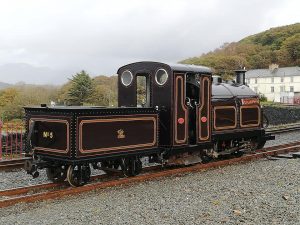
To discover more about Welsh Pony and many other aspects of Festiniog Railway history, visit Festipedia.
